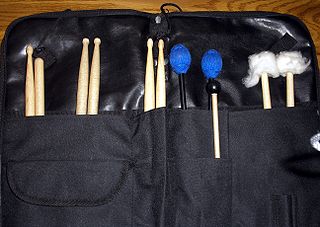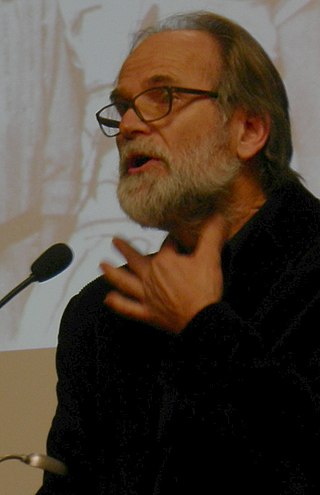
An electronic musical instrument or electrophone is a musical instrument that produces sound using electronic circuitry. Such an instrument sounds by outputting an electrical, electronic or digital audio signal that ultimately is plugged into a power amplifier which drives a loudspeaker, creating the sound heard by the performer and listener.

A percussion instrument is a musical instrument that is sounded by being struck or scraped by a beater including attached or enclosed beaters or rattles struck, scraped or rubbed by hand or struck against another similar instrument. Excluding zoomusicological instruments and the human voice, the percussion family is believed to include the oldest musical instruments. In spite of being a very common term to designate instruments, and to relate them to their players, the percussionists, percussion is not a systematic classificatory category of instruments, as described by the scientific field of organology. It is shown below that percussion instruments may belong to the organological classes of idiophone, membranophone, aerophone and chordophone.
Karplus–Strong string synthesis is a method of physical modelling synthesis that loops a short waveform through a filtered delay line to simulate the sound of a hammered or plucked string or some types of percussion.

The vibraphone is a percussion instrument in the metallophone family. It consists of tuned metal bars and is typically played by using mallets to strike the bars. A person who plays the vibraphone is called a vibraphonist,vibraharpist, or vibist.

Digital music technology encompasses the use of digital instruments, computers, electronic effects units, software, or digital audio equipment by a performer, composer, sound engineer, DJ, or record producer to produce, perform or record music. The term refers to electronic devices, instruments, computer hardware, and software used in performance, playback, recording, composition, mixing, analysis, and editing of music.
A music sequencer is a device or application software that can record, edit, or play back music, by handling note and performance information in several forms, typically CV/Gate, MIDI, or Open Sound Control, and possibly audio and automation data for digital audio workstations (DAWs) and plug-ins.

A player piano, also known as a "Pianola", is a self-playing piano with a pneumatic or electro-mechanical mechanism that operates the piano action using perforated paper or metallic rolls. Modern versions use MIDI. The player piano gained popularity as mass-produced home pianos increased in the late 19th and early 20th centuries. Sales peaked in 1924 and subsequently declined with improvements in electrical phonograph recordings in the mid-1920s. The advent of electrical amplification in home music reproduction, brought by radios, contributed to a decline in popularity, and the stock market crash of 1929 virtually wiped out production.
General MIDI is a standardized specification for electronic musical instruments that respond to MIDI messages. GM was developed by the American MIDI Manufacturers Association (MMA) and the Japan MIDI Standards Committee (JMSC) and first published in 1991. The official specification is available in English from the MMA, bound together with the MIDI 1.0 specification, and in Japanese from the Association of Musical Electronic Industry (AMEI).

A percussion mallet or beater is an object used to strike or beat a percussion instrument to produce its sound.

A MIDI controller is any hardware or software that generates and transmits Musical Instrument Digital Interface (MIDI) data to MIDI-enabled devices, typically to trigger sounds and control parameters of an electronic music performance. They most often use a musical keyboard to send data about the pitch of notes to play, although a MIDI controller may trigger lighting and other effects. A wind controller has a sensor that converts breath pressure to volume information and lip pressure to control pitch. Controllers for percussion and stringed instruments exist, as well as specialized and experimental devices. Some MIDI controllers are used in association with specific digital audio workstation software. The original MIDI specification has been extended to include a greater range of control features.

A sound module is an electronic musical instrument without a human-playable interface such as a piano-style musical keyboard. Sound modules have to be operated using an externally connected device, which is often a MIDI controller, of which the most common type is the musical keyboard. Another common way of controlling a sound module is through a sequencer, which is computer hardware or software designed to record and playback control information for sound-generating hardware. Connections between sound modules, controllers, and sequencers are generally made with MIDI, which is a standardized interface designed for this purpose.

Trimpin is a German born kinetic sculptor, sound artist, and musician currently living in Seattle and Tieton, Washington.

A Zendrum is a hand-crafted MIDI controller that is used as a percussion instrument. The Zendrum was influenced by the "Drumitar," invented by Future Man. There are several Zendrum models that are well-suited for live performances: the Z1, ZX, EXP, ZAP series, LT and the Mallet Pro series and Melodic Finger. The Zendrum ZX and Z1 can be worn like a guitar and consists of a triangular hardwood body with 24 touch-sensitive round MIDI triggers. The EXP has 29 triggers and additional controls. The Zendrum LT can also be worn with a guitar strap, and has 25 MIDI triggers in a symmetrical layout, which provides an ambidextrous playing surface. The ZAP series is designed more for table top use or on a drum stand, with the ZAP1 having 19 triggers, and the ZAP2 having 25 triggers. The triggers are played by tapping or slapping with the fingers or hands. As a controller, the Zendrum does not make any sound by itself. It uses an electronic interface called MIDI to control synthesizers, samplers, drum machines, sound modules, computers or other electronic drum devices that generates the musical and percussive sounds. The Mallet Pro Series is laid out and played like a traditional mallet instrument, like a marimba. The Mallet Pro series has naturally resonating solid walnut bars as triggers.
Andrew Schloss is an American musician and computer engineer.

Tod Machover, is a composer and an innovator in the application of technology in music. He is the son of Wilma Machover, a pianist and Carl Machover, a computer scientist.

An experimental musical instrument is a musical instrument that modifies or extends an existing instrument or class of instruments, or defines or creates a new class of instrument. Some are created through simple modifications, such as cracked cymbals or metal objects inserted between piano strings in a prepared piano. Some experimental instruments are created from household items like a homemade mute for brass instruments such as bathtub plugs. Other experimental instruments are created from electronic spare parts, or by mixing acoustic instruments with electric components.

Disklavier is a brand of reproducing pianos manufactured by Yamaha Corporation. The first Disklavier was introduced in the United States in 1987.
David Aaron Jaffe is an American composer who has written over ninety works for orchestra, chorus, chamber ensembles, and electronics. He is best known for his use of technology as an electronic-music or computer-music composer in works such as Silicon Valley Breakdown, though his non-electronic music has also been widely performed. He is also known for his development of computer music algorithmic innovations, such as the physical modeling of plucked and bowed strings, as well as for his development of music software such as the NeXT Music Kit and the Universal Audio UAD-2/Apollo/LUNA Recording System.
This is a partitioned list of percussion instruments showing their usage as tuned or untuned. See pitched percussion instrument for discussion of the differences between tuned and untuned percussion. The term pitched percussion is now preferred to the traditional term tuned percussion:
Morris Goldenberg was an American percussionist, music teacher, and method book author. He wrote several books on orchestral snare drumming, mallet percussion, and timpani. He is a member of the Percussive Arts Society Hall of Fame.














